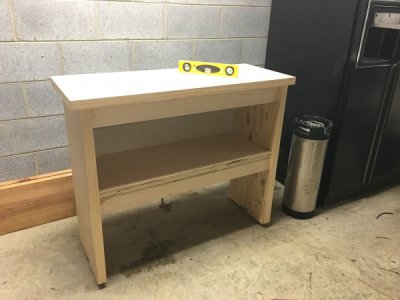That looks great! One nitpick: "Select pine" is not hardwood trim.

"Solid wood trim" would be more appropriate wording.
Are you up for a little constructive feedback about your finishing trouble? How about a ton of info I just felt like writing up on the subject?

Lacquer finish would not be my first choice for a project where there will be a variety of chemicals used. Polyurethane would be more appropriate here. It's a real tradeoff, as lacquer dries relatively quickly, at least to the point of applying additional coats, while oil-based poly takes ages to cure, so the finishing process really takes a while. A lot of people go with water based poly for that reason (Polycrylic is the most common name), but it lacks the warm color of the oil based variety and it has a greater tendency to raise the wood grain due to the water content. Lacquer is favored for projects which may need to be refinished later, such as an end table or other heavy use item, because applying additional coats years later results in the solvent carrier of the new lacquer dissolving the top most layer of the old lacquer, then drying & curing together for a seamless finish (if done right). Poly cures permanently (and quite durably; it's a plastic film), so future coats cannot be blended with the old ones. You can't sand it carefully to feather out a flaw in one layer, for instance. Anyway, the fact that the lacquer can be re-dissolved makes it non-ideal as a finish for a bench in a metal workshop.
The sandpaper finish you experienced was most likely the result of A) spraying from too far away, so the finish partially dries before landing, and you can't get a proper "wet out" which would greatly improve the finish of each coat; and B) not sanding between coats. I use about 320-400 grit between coats, VERY LIGHTLY just to remove the uneven surface without removing the bulk of the coat, and 1000 grit on the final coat. Those tiny bits of dried finish as well as bits of dust in the air combine to make a rough surface that has to be knocked down. You may have slightly raised the wood grain as well, though not as much as a water based finish would have.
"Sanding sealer" and "stain conditioner" products are typically a dilute lacquer which soaks into the wood grain and raising it slightly. After applying it you sand it back down lightly (220-320 grit works IMHO), but the lacquer remaining in the fibers prevents later coats from raising the grain, and prevents stain from soaking in. The stain then sits on top of the surface for a more even color but at the expense of any depth. Either product can be quite effective at improving the quality of your finish. Shellac would also be an excellent option for that "primer" coat. It's also an excellent final coat, as it is both compatible with and resistant to oils and water (but dissolves readily in alcohol). Just make sure you use de-waxed shellac if you want to try it as an underlying layer.
Finally after that last coat that gets sanded around 1000 grit (or even higher if you have it), you can buff it with rubbing then polishing compounds, and finally with paste wax, for a "French finish". Many gorgeous finishes you've seen may have had some of that "sandpaper" quality when first sprayed. I actually do that with my poly finishes as well, though with poly once you sand it with anything, no matter how fine, it can be very difficult to get a true gloss with any amount of buffing/polishing afterward. Semi-gloss is a good goal there.
HVLP will most likely help, as you will have finer control of the spray, but it won't do anything about those other factors without a well-designed and well-constructed dust-free negative pressure spray booth. And then you have to consider the tremendously combustible nature of nitrocellulose lacquer.
ALL of that said, for my shop projects I just use a blend of turpentine, beeswax, and boiled linseed oil. I keep some in a quart size paint can on the shelf. The turpentine dissolves the beeswax (alternatively you can just heat the product before using it to melt the wax). I do two coats, about half an hour apart. The linseed oil soaks into the wood and cures/hardens over the following week, while the beeswax mostly stays on the surface. After a couple hours for the turpentine to evaporate and the linseed oil to completely soak in, I buff the wax. That's it. I can apply more wax (I use paste wax for any future maintenance) if it ever becomes necessary, but it rarely is and it works very well to keep things clean. Oils and water just bead up and can be wiped off without a trace. Did I mention that it's CHEAP? Great stuff. I've even used it on woodworking products I've sold, as the beeswax is a very pleasant finish with an equally pleasant aroma.
 ). I guess in a couple of months, I'll help him build a new one.
). I guess in a couple of months, I'll help him build a new one.

